

Digital Collections, Available Online. American Memory from the Library of Congress - Home Page. Black Freedom Struggle in the United States: A Selection of Primary Sources. Lynching in America: Confronting the Legacy of Racial Terror. Chronicling America « Library of Congress - Digitale aviser 1789-1922.
Immigration Timeline - The Statue of Liberty & Ellis Island. By the 1880's, steam power had shortened the journey to America dramatically.
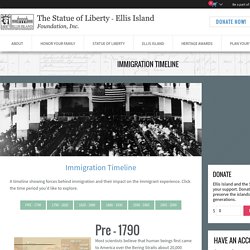
Immigrants poured in from around the world: from the Middle East, the Mediterranean, Southern and Eastern Europe, and down from Canada. The door was wide open for Europeans. In the 1880s alone, 9% of the total population of Norway emigrated to America. After 1892, nearly all immigrants came in through the newly opened Ellis Island. One immigrant recalled arriving at Ellis Island: "The boat anchored at mid-bay and then they tendered us on the ship to Ellis Island…We got off the boat…you got your bag in your hand and went right into the building. Families often immigrated together during this era, although young men frequently came first to find work. The experience for Asian immigrants in this period was quite different. The 1907 "Gentlemen's Agreement" with Japan extended the government's hostility towards Asian workers and families.
And for millions of immigrants, New York provided opportunity. Statistical Abstracts series. U.S. Electoral College. The American Presidency Project. Search U.S. Newspaper Directory, 1690-Present. The Entire Civil War Animated Map. Women and Social Movements in the United States, 1600-2000. Westerville Public Library. What was the Anti-Saloon League?

From 1893 to 1933, the Anti-Saloon League was a major force in American politics. Influencing the United States through lobbying and the printed word, it turned a moral crusade against the manufacture, sale and consumption of alcohol into the Prohibition Amendment to the United States Constitution. Under the motto "The Saloon Must Go," the organization worked to unify public anti-alcohol sentiment, enforce existing temperance laws and enact further anti-alcohol legislation. At first, the League appealed to local churches to carry its message to the people. Once they had established a loyal following, the League leaders focused their efforts on getting individual politicians elected who supported the cause. King Institute Resources. King Institute Encyclopedia. Civil Rights Digital Library. SoJust.net: Social Justice and Civil Rights Speeches.
Bella AbzugPlenary Address, Fourth World Congress on Women (1995) John AdamsInaugural Address (1797) Jane AddamsThe Subjective Necessity for Social Settlements (1892)The Modern Lear (1896) Susan B.
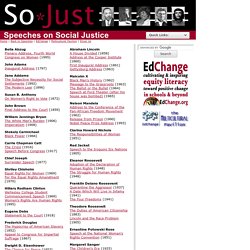
AnthonyOn Women's Right to Vote (1872) John BrownFinal Address to the Court (1859) William Jennings BryanThe White Man's Burden (1906)Imperialism (1908) Stokely CarmichaelBlack Power (1966) DocsTeach. Discovering The Civil War. Temperance & Prohibition. Our Documents - 100 Milestone Documents. The following is a list of 100 milestone documents, compiled by the National Archives and Records Administration, and drawn primarily from its nationwide holdings.
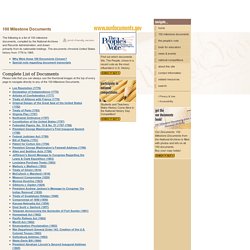
The documents chronicle United States history from 1776 to 1965. Complete List of Documents Please note that you can always use the thumbnail images at the top of every page to navigate directly to any of the 100 Milestone Documents. home 100 milestone documents the people's vote tools for educators news & events national competitions about this site contact information related resources search Privacy & Use Accessibility. University of Virginia Library.
Iraq and Afghanistan Veterans of America. Presidential Speech Archive - Miller Center of Public Affairs. Voices of Democracy. U.S. History In Context. National Archives and Records Administration. Religion and the Founding of the American Republic.
Witness and Response: September 11 Acquisitions at the Library of Congress. Creating the United States. The African American Odyssey: A Quest for Full Citizenship. The exhibition The African American Odyssey: A Quest for Full Citizenship, showcases the incomparable African American collections of the Library of Congress.
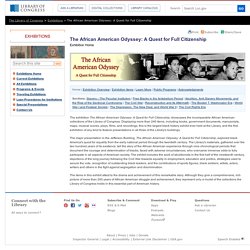
Displaying more than 240 items, including books, government documents, manuscripts, maps, musical scores, plays, films, and recordings, this is the largest black history exhibit ever held at the Library, and the first exhibition of any kind to feature presentations in all three of the Library's buildings. The Civil Rights Act of 1964: A Long Struggle for Freedom. President Lyndon Johnson speaking to the nation from the White House prior to signing the Civil Rights Bill into law, while (left to right) Attorney General Robert F.
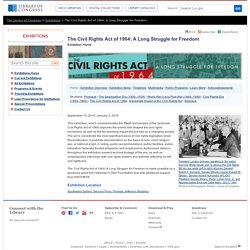
Kennedy, Senate Minority Leader Everett M. Dirksen, Senator Hubert Humphrey, AFL/CIO President George Meany, Martin Luther King, Jr., and Representative Emanuel Celler listen, July 2, 1964. Prints and Photographs Division, Library of Congress September 10, 2014–January 2, 2016. Finding Aid on the Cold War. Compiled by Tim Wehrkamp Contents Preface Introduction Records in Presidential Libraries Comprehensive Subject Matter Records Newsreels and Television Broadcasts Record Group 306 (Records of the United States Information Agency) Still Pictures and Motion Pictures Textual Records Electronic Records Record Group 273 (Records of the National Security Council) Textual Records Records of the Military Textual Records Electronic Records Donated Material Still Pictures Motion Pictures Intelligence Records Textual Records Reconnaissance and Satellite Imagery Foreign Policy Records Textual Records Still Pictures Records of Congress Textual Records Appendix I: List of Record Groups (RG) Cited in Reference Information Paper 107 Appendix II: Sources of Additional Information About Records or Finding Aids Described in Reference Information Paper 107 End Notes Preface NARA's descriptive program comprises a variety of information products.
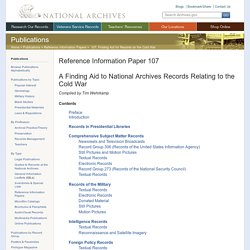
John W. Introduction.